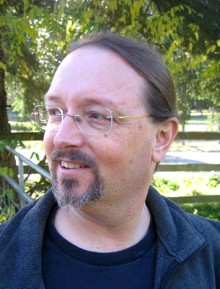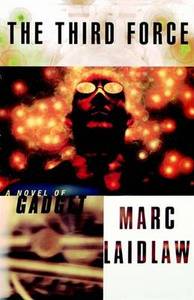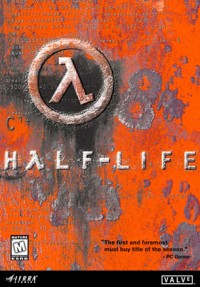 [Back in 1997 – when i was all of 22 years old – I was working in the game industry as a designer, at Kuju Entertainment in the UK. But I was also fascinated with writing about game development and design, even before I started contributing to Gamasutra in 1998. So I set out to interview a host of interesting game creators via email about the business.
[Back in 1997 – when i was all of 22 years old – I was working in the game industry as a designer, at Kuju Entertainment in the UK. But I was also fascinated with writing about game development and design, even before I started contributing to Gamasutra in 1998. So I set out to interview a host of interesting game creators via email about the business.
At that time, I think email requests for interviews were still fairly novel, so I got a fair amount of replies. I’ll be reprinting the most interesting ones on my blog over the next few months, to save them from the digital scrapheap – and we’ll start out with an interview with Valve’s Marc Laidlaw, even before Half-Life was released.
Later on, Marc was kind enough to write the foreword for my O’Reilly book Gaming Hacks. And it turns out my intuition in this interview that Half-Life would have a ‘degree of subtlety’ in it was correct, given the mighty franchise Valve has built – and currently sits on, Smaug-like. But, onward…]
It’s rare indeed that someone in the games industry has a past outside it. Sure, there’s the occasional architect drafted in for level design duties, but most of the people making games have never done anything but.
Which is what makes Marc Laidlaw all the more remarkable. From leading cyberpunk author and journalist to a writer and level designer at Valve Software, the makers of the forthcoming “Half-Life”, he brings quite a different perspective to computer game design. And it goes like this…
Simon: What was the first computer game you ever played?
Marc Laidlaw: As far as arcade games go, Tempest was my first addiction, but by the time the arcade craze started to sweep the nation I was already too old to really get the reflexes hardwired into my tender neurons. I was pretty lousy at the standards: Asteroids, Missile Command, etc.
At this time, the closest thing I’d seen to a PC was the Colossus in the computer center at the University of Oregon, where for a brief period I dabbled as a programmer, punching instructions on cards with a huge card-punching machine the size of a Geo Metro and then submitting them to the cranky guy behind the counter who would tell me to go away and come back in an hour (or two) to discover that my program had failed because of a punch-card typo in the first card.
So I lost my enthusiasm for computers pretty quickly. I played pinball. A year or so later, a friend of mine bought a Mac which played a little starship tailgunner game that was really unimpressive. My own computers were little more than glorified typewriters until a few years ago, when I played Myst while visiting some friends on Long Island.
I became obsessed. I went into Manhattan to visit my agent and told him I wanted to work on computer games. When I got back to San Francisco I bought a Pentium 60 with a color monitor specifically so that I could finish Myst. (That same P60, my only home computer, is now useless for playing Riven.)
 My agent soon landed me a great gig writing a tie-in novel for Haruhiko Shono’s Gadget CD-ROM, but that only fuelled my enthusiasm to become part of a game-design team, rather than a peripheral.
My agent soon landed me a great gig writing a tie-in novel for Haruhiko Shono’s Gadget CD-ROM, but that only fuelled my enthusiasm to become part of a game-design team, rather than a peripheral.
Simon: What was/is the attraction for you in making games?
Marc: I’ve been aching to do something pioneering. Storytelling is such an ancient form that it’s rather hard to break new ground in terms of content-but presentation is a different matter. Our means of relaying stories keeps changing over the ages-from oral traditions to written glyphs and characters, to films and now…computer games.
I think we are now passing into something like the “silent movie” era of computer game storytelling. The opportunity for making classics is very exciting. Twenty-five years ago I was writing about and trying to envision forms of 3D entertainment in my earliest science fiction stories; now I’m actually working in a field that I liked to dream about before it existed.
Simon: Does it give you something that writing could never do?
Marc: Writing is a solitary activity. I like working with people, being around people, doing stuff in a creative team. Seeing worlds take shape in Worldcraft and then in the game engine is a buzz akin to that of bringing things to life on paper. It’s a wonderful feeling when you make a map that mirrors something you’ve seen in your mind, then send it over the internet to someone else, and five minutes later they’re running around in your mind-scape.
Building maps in particular is a nonverbal activity, and sometimes my brain just gets tired of words and wants to think about geometry and spatial relationships instead of structuring sentences.
Simon: When did you first see ‘Quake’, and what did you think of it?
Marc: I first saw Quake at the offices of id when I was working on a piece for Wired Magazine. I was supposed to do an on-site-at-id feature, and it turned into a “Making of Quake” feature. Quake was very strange when I first saw it-some dark and moody corridors inhabited by blank grey entities that resembled Hoover uprights.
American McGee and Michael Abrash were deathmatching with these vacuum-cleaner monsters which were quite eerie, actually, because they didn’t have any of the cliche monster features, but they screamed when you shot them. None of the monsters had been imported into the game yet.
 I was impressed less by the look of Quake than by the tools with which it was actually made-the insider’s/designer’s view of the levels-the ability to noclip and travel in and out of your world and watch it unfold as you created it. That to me was the most exciting part of my first glimpse of Quake. I caught the mapping bug right then, especially seeing the stuff American was up to. Later, when Tim Willits arrived, he helped point me in the direction of actually starting to make maps.
I was impressed less by the look of Quake than by the tools with which it was actually made-the insider’s/designer’s view of the levels-the ability to noclip and travel in and out of your world and watch it unfold as you created it. That to me was the most exciting part of my first glimpse of Quake. I caught the mapping bug right then, especially seeing the stuff American was up to. Later, when Tim Willits arrived, he helped point me in the direction of actually starting to make maps.
Simon: When you were growing up you wanted to be a….?
Marc: Writer. Director. Cinematographer. Magician. Cartoonist. All of which, in a way, I’m doing now, rolled into one package.
Simon: What’s your job on ‘Half-Life’ currently entail?
Marc: I’m the designated writer, which means I’ve been wrangling with a lot of story elements that existed in the game long before I got here, and helping reshape them into something with the structure and feel of an actual story-one’s that not as obvious as it might appear on its face.
For instance, we start with the Doom-style gimmick of the dimensional portal through which horrors are pouring. But…you can’t just stop there. It was old when id did it, after all. Call it…a timeless theme. Anyway, you have to start looking for ways of handling these elements that no other designers would dream up.
I won’t take credit for the basic story, but if you finish playing the game and feel like what just happened made a strange kind of sense, then I would hope that’s because of some of the things I’ve been doing. In a creative group like the one at Valve, there’s no shortage of great ideas, and it often seems to me that other folks come up with the really wild ideas and simply use me as a sounding board and to see if their wild notions can get worked into the story somehow.
(As an aside, I was hired to get in early on the creation of Valve’s mysterious yet-to-be announced Second Game, so I’ll be taking more blame for that storyline.)
Simon: Do you feel at all overwhelmed in fitting into a job alongside people who’ve designing games for years?
Marc: Overwhelmed? No. Inspired and instructed? Yes. I’m always looking to the others to see what they think will work in a game. A game is not a novel, after all. I could come up with the coolest plot twist in the world, but if it doesn’t add to immersive gameplay, then it doesn’t belong in the game any more than jumping puzzles belong in a book.
Many of the folks here have a much better idea than I of what it takes to make a great game, and I rely on them to teach me. Gabe Newell, for instance, can sit down and look at a room and instantly come up with three ways of turning it into a place for fun gameplay.
I might look at the same room and think, “This is where our hero suddenly realizes that his domineering mother and passive-aggressive father ruined his chances of ever settling down and conquering just one world.”
 On the other hand, I’m learning constantly-that’s one of the joys of this job. By the time we’ve shipped Half-Life, I expect to have a pretty good grasp of what makes good gameplay.
On the other hand, I’m learning constantly-that’s one of the joys of this job. By the time we’ve shipped Half-Life, I expect to have a pretty good grasp of what makes good gameplay.
Simon: Do you think computer games will become widely accepted in the future as a valid artistic form?
Marc: It’s already happening. “Wide acceptance” is a double sword, though, because a lot of things get watered down when they find “wide acceptance.” One of my favorite games was “Gadget,” which was not actually a game, but a point-and-click movie. It was art of a very pure sort. But it did not find a “wide” audience. It’s a cult favorite, not a blockbuster. The size of Gadget’s audience or the width of its acceptance are irrelevant to whether it’s a work of art or not.
But Half-Life is a very different beast. It’s first and foremost a game. Whether this sort of game will considered “valid art” when the critics of the future look back on our primitive era, who can say? Do I care what their opinion might be? No. Am I using all the artfulness in my power to try and make this a really amazing game? Sure thing!
Simon: Valve are the only developers making Quake-engine games who have any degree of subtlety. Discuss?
Marc: If you mean that Half-Life is the only game with any subtlety, I don’t know enough about what the other Quake-engine games are actually aiming at to comment on this. If you mean that the company appears subtler than others licensing the Quake engine, then I’d have to say I’m not well placed to judge ourselves or other companies.
Maybe one reason we may appear to the outside world to have an iota of subtlety is because we don’t do plan files. The subtlest designer in the world can suddenly turn into a blathering idiot if you give him a soapbox of his very own. I’ve often made an idiot of myself in small forums (such as this one); and for this reason, plan files terrify me.
Yet I admit I am addicted to them. I read almost every plan I can get my hands on; I don’t want to look, but I just have to; it’s like rubbernecking as you pass a really bad traffic accident.
But seriously, long before I joined Valve I was impressed with something like what you’re calling subtlety. For months and months there was nothing on Valve’s website but a little map of the Seattle area. Long before Valve did any PR or made any public appearances, it was working hard on having a game worth promoting once the inevitable engines of hype kicked into gear.
And I have to say that a lot of the story and design decisions that have been made (and are being made every day) in the process of creating Half-Life are really interesting, risky, and even subtle ones. All this will lead to a more entertaining and unpredictable game, I believe. Of course, Half-Life itself will be anything but subtle. “The First Subtle Shooter” will not be a bullet point on our box!
Simon: What’s the part of Half-Life that you’re most proud of thinking up/designing?
Marc: Right now, I’m happiest with our plans to turn the player into a real character in the game, without making a snarling asshole out of him. The player is going to be important-and not only as a target. He’s going to feel he’s doing things for a variety of good reasons, including sheer survival.
 As for things I had absolutely nothing to do with creating, I love the monsters. Half-Life contains more incredible creatures, with incredible creature behavior, than just about any science fiction movie or book I can think of. We could put together the best zoo in the universe.
As for things I had absolutely nothing to do with creating, I love the monsters. Half-Life contains more incredible creatures, with incredible creature behavior, than just about any science fiction movie or book I can think of. We could put together the best zoo in the universe.
Simon: What advantages and insights do you think your cyberpunk literary background gives you in games? Are you coming at it from a slightly different angle to everybody else?
Marc: Well, I am familiar with all the science fiction tropes and cliches, and I don’t have to think for more than a fraction of a second to figure out whether some idea has been done to death or whether it’s fresh. That gives us a bit of an edge in this industry, I think, where a lot of game content seems to be derived from Hollywood’s brain-dead notions of science fiction rather than from the real living core of science fiction, which is its literature.
Sometimes I try to picture the game as if it actually were something in a futuristic novel-a really popular form of entertainment in the future-and then try to go about creating that game. It’s sort of funny that I was a cyberpunk, because in the typical cyberpunk scenario, the written word is dead-society is postliterate.
So far, I’m the first postliterate cyberpunk…abandoning text…a traitor to my class. But I may prove a turncoat twice, if I ever get back to writing anything apart from email and design documents.
[Original interview cut down slightly for modern relevance. Thanks to the long-defunct Videogamedesign.com for posting it in the first place!]